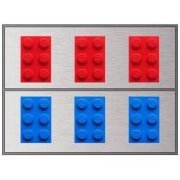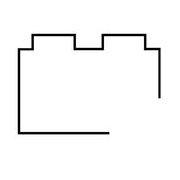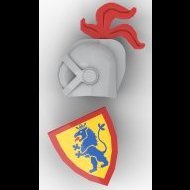Search the Community
Showing results for tags 'architecture'.
Found 375 results
-
In the 1960s, Northwestern University embarked on a construction frenzy. Skidmore, Owings & Merrill engineered the reclamation of 75-ish acres from Lake Michigan to roughly double the size of the university's campus in Evanston, Illinois. At the same time, Walter Netsch, an architect at SOM, was appointed to design several buildings, including University Library, for the new land. This is what he came up with. In plan, the design consists of a plaza oriented on an east-west axis, flanked by towers to the north, south, and east. Corridors on the west end of the library connect to the university's existing library, built in 1932-33. Netsch's concept, designed for the oncoming Digital Age, was that each of the three towers, organized around a central block, should house a different collection. Shelves in the stacks are arranged as spokes on a wheel so that a student should consult the computerized catalog in the center of the wheel to locate and obtain the desired material in minimum time with minimal hassle. It was, and perhaps still is, university policy that all buildings must be faced with limestone. Limestone is much too tasteful for Brutalist architecture, though, so University Library, and most of Netsch's other works on Northwestern's campus, are textured to make the limestone look like concrete. In the original plan, the central block from which the towers diverge was meant to be the entrance. Instead, Netsch's design was changed so the weird octagon thing became the entrance, because it is closer to the university's existing library. The central core still contains the elevators and bathrooms, but the intended entrance hall is now a cafe. Netsch raised the library's stacks on columns so that a person standing on the plaza, looking to the east, would have an uninterrupted view of Lake Michigan and the horizon. I'm sure it would have been a nice view, but Netsch's design was subverted in 1971 by the construction of another building immediately to the east of the library. I really don't like this building, but it was fun to design an architecture-type model based on it. All these images were rendered using Bluerender. Thanks for looking!
- 6 replies
-
- SOM
- Architecture
-
(and 1 more)
Tagged with:
-
Ulf Andersen's and my LEGO version of the Royal Customs House (Toldboden) located in Aarhus, Denmark. This building was part of a ca. 2 x 7,5 meter Christmas display 2020 at Salling Department Store, Downtown Aarhus.
-
Hi all, I'm very happy to introduce my latest modular building, coming after long months of university activities hijacking my free time. The set houses a leather shop in the far right building, inspired by Renaissance architecture, an empty house in the far left one, just sold to a new tenant, and a 13th century watchtower in the middle. Hope you like it!
- 11 replies
-
- renaissance
- italy
-
(and 3 more)
Tagged with:
-

[MOC][LEGO IDEA]Sentou Tenshu, Japan's Forgotten Past
Horlack Bricks posted a topic in LEGO Historic Themes
https://ideas.lego.com/projects/49ca9889-05fb-4887-ab3a-aad4add5237e Cultural link : https://en.wikipedia.org/wiki/Tenshu https://en.wikipedia.org/wiki/Onna-bugeisha https://en.wikipedia.org/wiki/Yumi https://en.wikipedia.org/wiki/Tomoe_Gozen https://en.wikipedia.org/wiki/Nakano_Takeko https://en.wikipedia.org/wiki/Ono_(weapon) https://en.wikipedia.org/wiki/Ōtsuchi https://en.wikipedia.org/wiki/Oyumi https://en.wikipedia.org/wiki/Oni https://en.wikipedia.org/wiki/Torii I love Ninjago and Japan. Thus was born this idea with historical consonance of medieval Japan, while being incorporable with Ninjago. I have been looking for a long time: to have a strong iconic and cultural medieval Japanese architecture, and to have a Ninjago aspect. The Soutou Tenshu ! In Japanese, a "Tenshu" is a multi-floor castle tower. A "Tenshukaku" is a Japanese castle. A "Soutou Tenshu" designates a particular architectural form, which is a smaller version of a Tenshukaku. There is no word in English or in Western culture for this type of construction. It’s not just a tower of a castle. It is a scaled-down reproduction of a main keep in a Japanese castle. In the West, this notion does not exist. To date, there are 12 original surviving Japanese castles. So few remain… The Soutou Tenshu are a cultural treasure in Japan; they are emblematic of its architectural sophistication, beauty and functionality. They are classified as a World Heritage Site by UNESCO. Soutou Tenshu - LEGO IDEA by Horlack, sur Flickr With my creation, I have not reproduced an existing Soutou Tenshu. I wanted an authentic representation of a Soutou Tenshu, but I also wanted to pay tribute to all the Soutou Tenshu which have disappeared over history. That is to say, I preserved the architectural spirit of the Soutou Tenshu, while allowing myself the freedom of imagination to incorporate playability into its construction for a child. The toy aspect of this for a child is just as important to me as its cultural fidelity to Japan. I have devoted myself to researching and uncovering ancient and long-forgotten aspects of Japanese culture. Whether just forgotten by time or lost in the writings of European historians who “westernized” the Orient too much. Modern history books have erased certain historical facts about Japan which did not agree with their vision of the western (often masculine) world, sometimes so much so that we forget about the Japanese themselves ! For example, today we know that Samurai often had katanas, an iconic and mythical Japanese sword. But we forget that many samurai did not have the financial means to buy such a prestigious weapon, which might cost them years, or even a lifetime, of salary. Likewise, we overlook the fact that there were more modest samurai who fought with axes, spears and bows. More importantly, we are unaware that there were samurai women, called Onna Bugeisha, who could make up 30% of an army. But modern Western feminism ignores the fact that the Japanese, 5 to 6 centuries before the Westerners, already had their feminism. No, feminism is not credited as a gift of our modern world. Thus, I intentionally incorporated into my Soutou Tenshu five powerful elements of ancient Japanese culture, forgotten and passed over in silence by Western reports. Personnagesi-01 by Horlack, sur Flickr 1 / A female samurai figurine with a Japanese longbow, named Daïkyu. Like the famous Samourai woman Tomoe Gozen, whose life gave birth to beautiful poems and tales. Woman of legend, with an extraordinary destiny, who commanded men. (Kimono based on figurine Ivy Walker - set 70620) 2 / A female samurai figurine with a long spear, named Nagamaki or Naginata. Like the famous woman Samourai Nakano Takeko, of the Aizu clan, who ordered up to 30% of samurai women equipped with this weapon, in her army. The length of the handle of the Nagamaki and Naginata, allowed women to keep an enemy at a distance, even if the opponent was stronger. The advantages of this weapon are a bit like the Greek phalanxes under Alexander. (based on Kimono Girl, Series 4) 3 / A male samurai figurine, with a large axe named a Masakari, and a small axe named an Ono. Representative of some samurai from low social class, such as farmers or monks (also named "samurai monk" or "warrior monk"); many of these men rose to the rank of samurai by their courage and loyalty to their lord. They often fought with weapons from their social class (like axes), because the Katana was inaccessible to them financially. (based on figurine Kendo Fighter, Series 15 & Samurai Warrior, Series 3 & Samurai, Series 13) 4 / A male samurai figurine, with a large mallet made entirely of hard wood known as an Otsuchi. This weapon was used by samurai from low social class. It was also effective for breaking down castle doors. Despite its heavy and rudimentary appearance, it was a formidable weapon to crush the leather and metal armor of enemy samurai (based on figurine Kendo Fighter, Series 15 & Samurai Warrior, Series 3 & Samurai, Series 13) 5 / The ōyumi, a defensive ballista. The ōyumi was a complicated type of giant crossbow, although historians are unsure of its appearance, as there are no real examples or illustrations known. Only five medieval texts refer to it. Historians agree that this weapon did exist, but it is one of the forgotten weapons of Japan’s past, and its details have been lost in history. The construction of Soutou Tenshu, with a certain free interpretation to be compatible with the gameplay: Ground floor : -Door with stylized Oni face -Stylized portal (or Torii), with emblem of Japan (wink) -Forge / blacksmith -Well water -Water and sake reserve (wink) -Prison / warehouse room -Ōyumi ballist -Various weapons. -Sakura Cherry blossom tree (emblematic tree of Japan) First floor : -Kitchen -Dining room / refectory -Weapons room / training room Second floor : -Bedroom Base : Folding base with 3 basic hinges (pivots) on the outsides, and a triple system of internal hinges per pivot, to stabilize and strengthen the base, with part number 19954 Hinge plate 1x2. When the base is closed, the stability and structural integrity is increased by the triple internal hinge system, and also by the 4 train magnets hidden in the walls of the ground floor. . Play functions : Everything is playable and functional. You can open the Tenshu by the hinges of the base, or by lifting the building floors like the LEGO Modular sets. Everything is accessible both horizontally and vertically. Working : Make with LEGO Digital Designer and Studio (Bricklink). There are 2987 bricks without minifigurines. The project required around three weeks of working and 72 hours of 3D rendering (calculation). If you love Japan, or your kids love Lego Ninjago, then support me ! thanks you very much. -

[LEGO IDEAS] King Kong 🦍 Wall 🚪 and Skull Island 🗺️ (Updated)
MasterStud posted a topic in Special LEGO Themes
Project Link: Support for free using the LEGO Ideas website to help get this project to 10,000 in hopes that it becomes a LEGO Ideas set! Make LEGO King Kong Happen! https://ideas.lego.com/projects/4f6b80c5-6ce4-4f80-9688-a1762e28b187 Shorter url version: http://www.tinyurl.com/Konglego King Kong Two-Legged Lizard + References Dragon Dinosaur + References Trex + References Spider + References Display all figures and creatures at front If you like the set it is also available on LEGO ideas to support for the chance of it becoming an official set! link if interested: https://ideas.lego.com/projects/4f6b80c5-6ce4-4f80-9688-a1762e28b187 The Log Posed The Trex Spider from the Ravine Two-Legged Lizard attacks John Side of Wall The Cave The Natives The Gong Ann on tree Back of Spider Dragon looking Dinosaur (Son of Kong) https://ideas.lego.com/projects/4f6b80c5-6ce4-4f80-9688-a1762e28b187- 6 replies
-
- teeth
- sharp
-
(and 85 more)
Tagged with:
- teeth
- sharp
- tail
- webs
- spider webs
- gold
- golden
- relic
- deteriorating
- plate techniques
- old
- wooden ladder
- cracks
- oak tree
- ladder
- palm tree
- skulls
- bark
- entrance
- moss
- dinosaur
- dragon
- platform
- altar
- dinos
- crab
- crab monster
- claws
- spider
- spider pit
- pseudoscorpion
- ravine
- vines
- decals
- custom decals
- captain
- textures
- figures
- minifigure
- camera crew
- camera
- wooden door
- doorway
- gate
- king kong 1933
- king of kings 1927 king solomons temple design
- treasure
- roman pillars
- pillars
- hut
- statue
- two legged
- egs
- two-legged
- chief
- lizard
- capt. englehorn
- native chief
- carl denham
- ann
- ann darrow
- john driscoll
- monkey
- ship crew
- crew
- ape
- natives
- islanders
- gong
- ancient
- temple
- architecture
- wall
- jungle
- trees
- green
- gorilla
- shrubbery
- king
- island
- trex
- king kong
- skull island
- jaw
- scary
- monstrous
- creatures
-
Hello, I'm proud to present to you my newest MOC, Willis Tower, formerly Sears Tower, at a 1:400 scale. Pieces - 23,037 Height - 131 Centimetres (51.4") My take on the iconic Willis Tower, formerly Sears Tower. The structure of the tower itself is relatively simple as it is just the same four patterns repeated. That said, The base more than made up for the tower's lack of complexity. Featuring sloped roads and split level entrances it took a lot of trial and error and of course, time, to get to this result. I am really quite happy with how this model turned out. It was worth all the effort. I cannot wait to try my hand at more skyscrapers in the future. The Willis Tower is a 110-story 1,450-foot (442.1 m) skyscraper in Chicago, Illinois At completion in 1973, it surpassed the World Trade Center in New York City to become the tallest building in the world, a title that it held for nearly 25 years; it was also the tallest building in the Western Hemisphere for 41 years, until the new One World Trade Center surpassed it in 2014. While it held the title of "Tallest Office Building" until 2014, it lost the title of "Tallest Man-Made Structure" after only 3 years. The CN Tower in Toronto, which serves as a communications tower, took over the title in 1976. The Willis Tower is considered a seminal achievement for architect Fazlur Rahman Khan. It is currently the third-tallest building in the United States and the Western Hemisphere – and the 23rd tallest in the world. Each year, more than one million people visit its observation deck, the highest in the United States, making it one of Chicago's most popular tourist destinations. The structure was renamed in 2009 by the Willis Group as a term of its lease. More pictures can be found on my Flickr, https://www.flickr.com/photos/186855130@N08/albums/72157713216189008 -TJ
- 3 replies
-
- tower
- architecture
-
(and 3 more)
Tagged with:
-
I designed the US Supreme Court in the style of the Architecture Landmark series! Since the building is actually quite long in its depth, I took inspiration from the overall approach of the official Trafalgar Square set. The rear side of the building also features a super micro version of the famous courtroom! Let me know what you think!
- 3 replies
-
- architecture
- landmark
-
(and 3 more)
Tagged with:
-
Hello there, my name is Simon from Simons Brick World. I´m happy to see so much Lego fans in here and also such pretty and awesome builds. I started a small YouTube Channel in 2020. Since this time, my passion for building MOC´s cannot be stopped. My plan is to show people without space or capabilities that there is a good way creating Lego buildings and MOC virtual. I show them what is possible and try to give them some ideas to start their own online projects. Since the launch of my channel, I try to upload a new video every week. I would be very happy if you visit my YouTube Channel and maybe support me and my plan with a subscribe or by promoting the idea. You can also visit my brand new Instagram Account, named: simonsbrickworld Tell me if you want me to post my new MOC´s here too. Thanks for your time Happy Building Simon from Simons Brick World
- 1 reply
-
- moc
- architecture
-
(and 4 more)
Tagged with:
-
Hi everyone It's been a while since I've posted a MOC on Eurobricks, in fact this is my first new MOC for over a year and the first building I've designed for almost 2 years. Anyway this is my latest creation "The Village Post Office". The model represents a typical British Post Office from the early 1930's and also features a vintage mail van. At first glance it may look like a modular but it is not. The model features an open back design and the different levels can't be separated. The base is also much different in size and design to a standard modular building. In total the model contains 2262 pieces. Here are some shots of the exterior... Notable features include an iconic red phone box, pillar box a bench and a tree. A series of steps at the side give the minifigs access to the first floor. INTERIOR DETAILS As mentioned earlier the building has an open back to give access to the interiors. On the ground floor is the main Post Office itself. I've tried to give this a rustic, vintage appearance with wooden floorboards and wood panelled service desk. Details include a cash register, lable dispenser, a set of weighing scales and shelves behond the desk for sorting all the mail. Opposite the desk is a parcel wrapping station. The idea for this was stolen borrowed from the Elf Clubhouse set. On the first floor above I've added an apartment which is home to the couple who run the Post Office. This is packed with everything they need including a bed, fireplace, kitchen and an antique gramophone. I didn't have space to include a toilet - but at least they have a bucket. VINTAGE MAIL VAN The mail van is a traditional red style truck as would have been used in Britain during the early 1930's. It is 6 studs wide and features opening rear doors and a removeable roof. The emblems on the van and postman are bespoke prints I created for this model. MINIFIGS AND OTHER DETAILS The model contains 4 mnifigs, a postman, customer and the husband and wife who run the post office and live in the appartment above. I've also included a bike and several animals. LEGO IDEAS My reason for designing this with an open back and with a unique style base was to try and distance it as much as possible from the modular buildings and hopefully give it a better chance of success on LEGO IDEAS. My hope is that if this was lucky enough to reach 10K then LEGO would view it as a standalone building in a similar way to The Old Fishing Store, and not something that would conflict with the modular building series. Anyway I hope you like the model. I had a lot of fun designing this one.. Feel free to let me know what you think. I'd also be massively grateful if anyone would be kind enough to support it on LEGO IDEAS as well. https://ideas.lego.com/projects/16ae1e95-cf30-41dd-ae23-36e07668df05 Thanks very much.
- 31 replies
-
- lego ideas
- post office
-
(and 7 more)
Tagged with:
-
Saint Basil's Cathedral is an Orthodox church in Red Square of Moscow, and is one of the most popular cultural symbols of Russia. The building, now a museum, is officially known as the Cathedral of the Intercession of the Most Holy Theotokos on the Moat, or Pokrovsky Cathedral. It was built from 1555 to 1561 on orders from Ivan the Terrible and commemorates the capture of Kazan and Astrakhan. I spent about 2 months to build this LEGO model. More photos: Lasse Vestergård | Flickr
- 3 replies
-
- architecture
- church
-
(and 2 more)
Tagged with:
-
I've been building occasional Lego Architecture sets for a few years now, but the series now seems to be well-and-truly moribund. Just tourists traps and Skylines that don't appeal (although the Miami skyline on Ideas is rather nice). But I've always had a train interest too, and the Crocodile caught my attention last year, and I was hooked.I needed more than that to keep myself busy, and I had a collection of OO scale model railways that, in all honesty, were never going to see a layout, so I sold them and switched to Lego trains.I started with two City Train sets, 60197, at good prices, but they really needed a proper station to do them justice. Like many people I think that the Metro Station 4554 is one of the nicest that Lego has ever created. I completed this in Tan, and replaced the windows with panels, which give it a nice 1930s look. I needed another building for the other platform. Lego does Brutalism really well, and 7997 looks the part in Light Grey. The station buffet is long closed, a victim of economies. Together, parting up 4554 and 7997 are a really good lesson in learning the ins and outs of Bricklink and the waywardness of Lego parts colour availability. These are both nice stations, but I wanted something a but more grand and old fashioned. The Disney Train station 71044 is really the only large station that Lego has ever created (it keeps rejecting good stations on Ideas), and I managed to get just the building by itself for a very reasonable price from Ebay. Of course, platforms are needed too. Several Harry Potter stations combine nicely to create an attractive substantial set-up. Although the Disney station is large, it still gives the impression of a country town station rather than a major city terminus. The next step was a chance encounter with a book on the history of Lego sets. The Town Hall in 10184 looked too good to stay as a Town Hall: I could see a Neo-Gothic Victorian monument struggling to get out. St Pieces is the main central station on the layout in my head. Typical Victorian grandiosity (as per St Pancras). I followed the original 10184 plans to the letter and then extended outwards and upwards. My big lesson was not to design like this. It is much better to start with a concept and a blank slate rather than adapt someone else's design. For the record I will note that the 2x2x3 roof slope is HORRIBLE, that part doesn't have clutch, it has anti-clutch, and that roof exploded messily at every opportunity. All those joists in the loft are there for a reason. The desire to return to Brutalism was strong, showcasing just how nice a such a building can be when done well. Inspired by the Royal Festival Hall, Falmer House (University of Sussex) and the Crystal Palace Sports Centre, for Festival Gardens Station I particularly wanted to show the metal-framed windows that characterise these buildings, and I've always wanted to do a circular roof. Initially, I thought I had cursed myself by making the whole building an odd-number of studs wide but the Lego gods were merely testing my resolve: the circular roof went together with the main building like a dream and fitted perfectly. I just wish there were more inverted slopes available. I thought that Festival Gardens would be the last stop on my journey, but Art Nouveau has always been my first architectural love, and ideas started forming in my head about ways to make it possible. You've already seen Botanical Gardens, but here are a few photos again so you can see my full journey! So, that's my long MOC journey come to an end. I hope you enjoyed the results. I think that's exhausted my inspiration for now, but who knows what might pop into my head next! If any of these buildings generate particular interest I will start a separate thread for them with extra photos, I need the practice!
- 14 replies
-
Had to share this. I've long enjoyed Art Nouveau architecture, and implementing it well in Lego has stretched many minds. Lego's plant pieces give the easiest route and I decided to exploit this.Botanical Gardens station is a then-innovative steel-framed building designed to be airy and spacious and let in as much light as possible. It features a glass first floor and roof, and plenty of electric lights. There are ticket windows, a small buffet and upstairs is a restaurant (the Rose Garden) and railway office.The interior is inspired by the adjacent botanical gardens, with the steelwork inside exposed but lavishly decorated.The inspiration is the Brussels Comic Strip Museum, designed by Victor Horta, and a small but lavish church in the Essex, UK suburb of Brentwood.Enjoy. [Apologies for zero photography skills]
-
Greetings! I have recently took upon myself the task of recreating one of my favourite buildings lost to the ravages of war: St. Alexander's Church in Warsaw, Poland. It's quite an ambitious project (over 20,000 bricks) that I intend to finish by October. Background information: The church was completed in 1825 and was built in the neoclassical style. In the 1890s, the Russians, who occupied Poland, decided to remodel the building architecturally and expand it considerably. The temple was practically intact following the German invasion of Poland in 1939, and was almost completely razed to the ground as part of the planned destruction of Warsaw in late 1944 (only one of the bell towers survived). After the war, the church was rebuilt, however in its original form, not the one after the 1890 alteration (probably due to a combination of insufficient funding and the opposition to the Church by the new communist regime). My aim was to rebuild the church as it stood between 1890 and 1944. Notes on the build: Dimensions: the building itself measures 132cm x 76cm x 54cm (the build is situated on a 2x4 grid of 48x48 baseplates) Many people may be annoyed by this, but I decided not to build the interior for two reasons; one is practical, the other is technical. As for practicality, I came up with an idea to insert some LED lighting into the church so that it can be illuminated, which should combine beautifully with the trans-coloured bricks that make up the stained glass windows. Inserting a power source, wiring, lights, controlled, etc. may have been problematic with a completed interior. Regarding technicality, I conducted a lot of photographic research before designing the model in Studio. While pictures of the exterior are not difficult to come by (owing to the fact that the church was one of the architectural crown jewels of pre-war Warsaw), I had only found one of the interior, and the quality of it was insufficient to provide an appropriate representation of the interior. Although written accounts of the interior do exist, I wanted to stay true to the original. Granted, one cannot replicate everything in Lego (especially me, a mediocre builder at best), but I didn't want my imagination to taint the build. Photos of the actual church: (The church after being destroyed. Notice the one surviving bell tower. The bricks you can see in the foreground came from the church and were used to build other buildings for the returning population following their expulsion after the failure of the Warsaw Uprising). Renders: Note: the renders aren't complete, primarily because of technical limitations. I'm running an Intel i7 with a GTX 1080 and even that setup struggles sometimes. Also, the angles of the build make working in Studio annoying at times. Some elements that I wanted to put Studio considers as colliding with others (particularly when it comes to the dome), so I've decided to just do them in real life instead. These include the top of the dome, the roofing adjacent to the dome base, the statues on the roof, and some minor details here and there. The greatest challenge will be the walls of the dome; as you can see they're empty, and I may have to resort to non-Lego means. Building: More to follow! Most of the workpace is dictated by how fast the BrickLink orders arrive at my place.
-
I've tried to build something new for my digital microcity project. Inspiration was East Slovak Museum in Kosice. Scale is finaly slightly bigger, then my other buildings, but not too much. I've made it in LDD/studio.
-
Here it is, my newest model, the Woolworth Building. The Woolworth Building is an early American skyscraper located in Manhattan, New York City. Designed by architect Cass Gilbert, it was the tallest building in the world from 1913 to 1930, with a height of 792 feet (241 m). Located in Manhattan's Tribeca neighborhood, The 60-story structure consists of a 30-story tower situated atop a 30-story base. Its facade is mostly decorated with terracotta (though the lower portions are limestone) and contains thousands of windows. The skyscraper was originally conceived by F. W. Woolworth, the founder of a brand of popular five-and-ten-cent stores, as a headquarters for his company. Woolworth planned the skyscraper jointly with the Irving National Exchange Bank, which also agreed to use the structure as its headquarters. Construction started in 1910, and it was completed two years later. The Woolworth Building underwent several changes throughout its history. The top thirty floors, formerly used as office space, were sold to a developer in 2012 and subsequently converted into residences. The remainder of the building remains in use by office and commercial tenants. This model stands at 63cm tall and contains ~8,500 pieces, built at a 1:400 scale. There is a lot of techniques I had to come up with to be able to get all of the details in the façade and the roof. The details of the Woolworth Building are so intricate that it would be impossible to include everything at this scale but I tried my best to make it work. Overall, I'm really happy with the way it has turned out and I can't wait to get started on my next build.... More pictures can be found on my flickr: https://www.flickr.com/photos/186855130@N08/albums/72157713858882581
- 4 replies
-
- tower
- skyscraper
-
(and 3 more)
Tagged with:
-
My new Project begin : Pay tribute to Marseille City ------------------------------------------------------------------ November 2020 Basilica Notre Dame de la Garde Marseille City Theme : Architecture and City Made by Uruk/ Hugo ----------------------------------------------------------------- ----------------------------------------------------------------- EN Notre Dame de la Garde in few figures : Outer length : 52,2m Outer width : 16,8m Cupola diameter : 6,8m Height of the statue of the Virgin Mary : 11,8m FR Notre Dame de la Garde en quelques chiffres Largeur exterieur : 52,2m Longeur exterieur : 16,8m Diamètre de la coupole : 6,8m Hauteur de la statue de la Vierge : 11,8m -------------------------------------------------------------------- EN Notre Dame de la Garde is a minor basilica from the 19th century. Emblem of Marseille, it dominates the city and the Mediterranean sea from the top of La Garde hill. It replaced an old chapel dating from 1214 because Marseille population could not go to require it because the space was cramped. The work is by Jacques Henri Esperandieu, a young architecture of 23 years old. FR Notre-Dame-de-la-Garde est une basilique mineure du XIXᵉ siècle. Emblème de Marseille, elle domine la ville et la mer Méditerranée depuis le sommet de la colline Notre-Dame-de-la-Garde. Elle remplaça une vieille chapelle datant de 1214 faute de places L'oeuvre est de Jacques Henri Esperandieu, un jeune architecte de 23ans. ------------------------------------------------------------------- BasilicNotreDame by Hugo, sur Flickr ------------------------------------------------------------------- EN My work in few figures : 120 hours to build the Basilic 50 hours to modelising on the logiciel Studio 2.0 3180 bricks FR Mon travail en quelques chiffres 120 heurs pour construire la Basilique 50 heures pour le modéliser sur le logiciel studio 2.0 3180 bricks lego en tout --------------------------------------------------------------------- EN The construction of the work in Lego requires more than 3000 bricks. The proportions are practically respected even if a caveat must be asked: the statue of the Virgin Mary in reality is the size of the Dome. It's hard to imagine such a large Virgin in Lego. The interior of the Basilica has also been redone on a microscale. I hope you will enjoy reproducing this construction, emblem of an entire Marseille people. FR La construction de l'oeuvre en Legonécessite plus de 3 000 bricks Lego. Les proportions sont pratiquement respecté même si un bémol doit être posé: la statue de la vierge Marie en réalité fait la taille du dôme. Difficile de concevoir une Vierge aussi grande en lego. L'intérieur de la Basilique a aussi été refait à l'échelle microscale. Là aussi, difficile de refaire à l'identique l'oeuvre d'Esperandieu. J'espère que vous apprécierez de reproduire cette construction, emblème de tout un peuple marseillais -------------------------------------------------------------------- Top donateur : - DocMariachi (instagram) ------------------------------------------------------------------ If you liked my work, please subscribe on my instagram/ Flickr, likes the pictures And if you want to support me : https://utip.io/uruk In addition, if you want to redo my creation, you can buy the notice on Rebrickable : Rebrickable ----------------------------------------------------------------- This is juste the first step of my project : pay tribute to my city : Marseille A lot of new things will come in 2021.
- 4 replies
-
- marseille city
- architecture
-
(and 1 more)
Tagged with:
-
Typical Chinese building Inspired by: Forbidden City in Beijing, China (built in 1406-1420) This building is a part of a series of 21 buildings built in different architectural styles. Each building is built on one 32x32 baseplate: https://www.flickr.com/photos/66344850@N06/albums/72157708211032315
- 2 replies
-
- architecture
- china
-
(and 1 more)
Tagged with:
-
Typical Hindu Temple Inspired by: Shree Sanatan Hindu Mandir in London, United Kingdom (built in 2010) Angkor Wat in Cambodia (built in the 12th century) Kandariya Mahadeva Temple in Madhya Pradesh, India (built in the 11th century) Mukteshvara Temple in Odisha, India (built in the 10th century) Ganesha with the elephant head is one of the best-known and most worshipped deities in the Hindu pantheon: This building is a part of a series of 21 buildings built in different architectural styles. Each building is built on one 32x32 baseplate: https://www.flickr.com/photos/66344850@N06/albums/72157708211032315
- 3 replies
-
- architecture
- hindu
- (and 4 more)
-
Hi everyone I'd like to present my latest MOC, a new modular building called Bricks & Blooms. I hope you like it. Bricks & Blooms is a modular Garden Centre built over 3 levels on a 32 x 32 base plate. in total it uses 2587 bricks. The facade is supposed to give the impression of being 2 buildings side by side but it is of course just one single building. The front to back measurement of the building is quite narrow, similar to Parisian restaurant. This is because I wanted to maintain plenty of space at the rear of the building for the main outside garden centre / plant sale area. THE MINIFIGURES I've included 6 mini figs and a cat with this MOC. Left to right they are: 2 customers (a father and his daughter), The garden centre shop keeper and gardener, the chef and the Aquatics shop assistant. THE GARDEN CENTRE AND GROUND LEVEL DETAILS The main garden centre area of the store is situated on the ground level. Outside on the street, I've included a tree, bench and lots of plants and flowers for sale. The garden centre also has a fruit and veg stall that sells it's produce directly to passers by on the street. Inside the shop I've included the cashier desk and more plants and gardening tools for sale including a little lawn mower side-build. Here is the interior of the fruit and veg stall that is accessed through a door at the back of the cashier desk. A door at the back of the shop leads out in to the main outdoor gardening area. Here I've included a large glass canopy covering rows of tables holding bedding plants. There are also more flowers, pots and other gardening products including a water feature. The stairs at the back of the building lead up to level 2. LEVEL 2 - CAFE/RESTAURANT No garden centre would be complete without its own cafe/restaurant. The cafe on level 2 has a fully equipped kitchen with serving desk and tables and chairs for the minifigs. There is also a small balcony in the cafe that looks out on to the street below. LEVEL 3 - AQUATICS Many garden centres here in the UK also have departments that specialise in pet fish and Aquatics. Bricks & Blooms is no exception and has it's own dedicated Aquatics section on level 3. The Cat below seems to have its eye on the goldfish. The door behind the desk leads out on to a small roof terrace area. FLOWER CART The model also includes a flower cart. THE FINISHED MODEL The picture below shows Bricks & Blooms combined with my other modulars and vehicle MOC's. Left to right they are. The Queen Bricktoria Convenience Store Brick Square Post Office Bricks & Blooms The Old Workhorse - Traction Engine LEGO IDEAS I have submitted Bricks & Blooms as a LEGO Ideas project. If you like the model I'd be really grateful if you'd be kind enough to head over to LEGO Ideas and give the model your votes. You can find the project at the following link. Many thanks! http://bit.ly/bricksblooms I hope you like my newest MOC and thanks very much for reading. As always, there are many more pics on my Flickr page and feel free to leave comments and let me know what you think.
-
A Castle designed by me for my Kids i such a way as to be as playable as possible. Detailed description and more pictures You'll find on my entry on Lego Ideas. I'll be grateful for Your comments. If You like it, please support on Lego Ideas leave Your comment and don't forget to share with Your Friends :)
- 8 replies
-
- building
- architecture
-
(and 7 more)
Tagged with:
-
Typical Ottoman mosque Inspired by: Sultan Ahmed Mosque in Istanbul, Turkey (built in 1609-1616) Süleymaniye Mosque in Istanbul, Turkey (built in 1550-1557) This building is a part of a series of 21 buildings built in different architectural styles. Each building is built on one 32x32 baseplate: https://www.flickr.com/photos/66344850@N06/albums/72157708211032315
- 7 replies
-
- architecture
- mosque
-
(and 2 more)
Tagged with:
-
Sudano-Sahelian building Inspired by: Great Mosque of Djenné in Mali (built in the 13th century, but reconstructed in 1907) This building is a part of a series of 21 buildings built in different architectural styles. Each building is built on one 32x32 baseplate: https://www.flickr.com/photos/66344850@N06/albums/72157708211032315
- 1 reply
-
- architecture
- mosque
-
(and 2 more)
Tagged with:
-
Moorish building The exterior is inspired by: Patio del Yeso in the Alcázar of Seville, Spain (built in the 12th century) The interior is inspired by: Great Mosque of Córdoba, Spain (built in 784 with later extensions) This building is a part of a series of 21 buildings built in different architectural styles. Each building is built on one 32x32 baseplate: https://www.flickr.com/photos/66344850@N06/albums/72157708211032315
- 3 replies
-
- architecture
- moorish
-
(and 2 more)
Tagged with:
-
Norwegian stave church from the Middle Ages Inspired by: Heddal Stave Church in Norway (built around year 1200) Borgund Stave Church in Norway (built around year 1200) This building is a part of a series of 21 buildings built in different architectural styles. Each building is built on one 32x32 baseplate: https://www.flickr.com/photos/66344850@N06/albums/72157708211032315
- 6 replies
-
- architecture
- norse
-
(and 3 more)
Tagged with:









